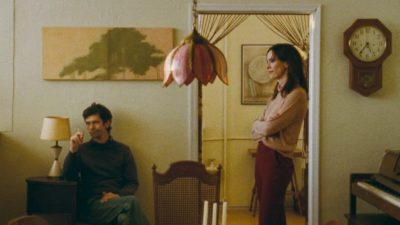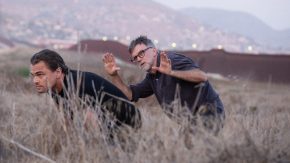LINE MOVEMENTS – ANI MOLNÁR GALLERY
The Line Movements exhibition of Tamás Konok is coupled with the saddening fact that the artist himself is not able to be present at the vernissage. Tamás Konok, the doyen of geometric abstraction was recognised both in the domestic and international art scene. His art strongly relates to European modernism, to the geometric abstraction of Central-Eastern Europe and the constructivist tendencies.
The selection by Ani Molnár Gallery aims to represent Konok’s specific linebased structures, grounded in the European tradition of line aesthetics, and to highlight connections between his diverse artistic periods from collages and monotypes of the 1960’s to his artworks after the turn of the millennium.

The memorial exhibition is the 60th exhibition of Ani Molnár Gallery. In his period from 1959 to the first part of the seventies, Konok creates abstract collages and paper works. Already from this point on the question of line-based transparent structures appears in his works, which eventually unfolds in 1975 when truly abstract, progressively clearing image-structures begin to appear based on the tradition of German-Swiss art, the concrete art of Zurich, and the geometric abstraction of École de Paris.
Konok uses an array of motives and paints his compositions in more variations aiming for the expression of abstract and transcendent content. He uses in the so called “Graphidions” an authentic line-based structure. The line that can barely be found in nature but more so is connected to human activity. He even returns to these schemes and patterns around the 2000’s (Greenish graphidion, 2008). Such experimental approach, the desire of discovering the relation between forms, as well as the motive and composition variations remain characteristic of his later periods too.

His way of thinking can be sensed through the process-like displacements, equilibrium, and more so through the presentation of dispositions (Yellow accent, 1980). The pictorial elements are not structured according to symmetry and repetitive rhythms, but through “motiveconcentration”. In fact, often times the artist enhances a main motive – a form that evokes figurative associations, and thus stand on the border of figuration and abstraction (Extension, 1975).
Curator: Lili Boros, art historian
Exhibition Layout: Eszter Lázár
English Translation: Eszter Novák
Special Thanks to Marianne Konok, Virág Dományi, Orsolya Novák
On view: 17 December 2020 – 13 March 2021
VERS L’INFINI. TAMÁS KONOK’S OEUVRE EXHIBITION – LUDWIG MUSEUM
The Ludwig Museum planned to celebrate painter Tamás Konok’s 90th birthday with a large-scale oeuvre exhibition. In view of the emergency situation, the exhibition was postponed from September to December, and more than a hundred works by Tamás Konok had been installed by the opening on December 10, 2020. However, due to the latest epidemiological measures, the exhibition cannot open and will be available for visit from 12 January at the earliest.

It is more than painful for us that Tamás Konok, at the zenith of his creativity and surrounded by general respect and love, did not live to see the opening of the exhibition, for which he made new works, and his friends organized festive programs, concerts and conversations. The event thus turned into a memorial exhibition honouring the unique, special, constantly renewing art of Tamás Konok, under the title “Vers l’infini” (“to infinity”), borrowing the title of one of the artist’s works.
In recent decades, smaller and larger selections of Tamás Konok’s oeuvre have been organized, and like the previous ones, this exhibition cannot provide a complete overview of the oeuvre, which includes more than four thousand pieces and spans seven decades; it only flashes his art periods, the typical genres and themes. The material of the exhibition was selected from the artist’s studio, with his contribution, with a strong emphasis on the latest works made in the 2000s and 2010s, which proved the artist’s seemingly inexhaustible zest for life and creativity with their formal variety and striking colours. The larger part of the exhibition is made up of these large-scale pictures, which summarize his work while at the same time seek new ways.

A smaller selection focuses on the naturalistic paintings made in the 1950s and then the path-finding collages and graphics of the 1960s, which were made after he settled in Paris in 1959. Konok’s art gradually clarified from the seventies onwards, and he developed his characteristic geometric painting based on the order of lines and the balance of colours, a form of representation he called Graphidion. Starting from the eighties, he experimented again with new image forms, spatial structures and architectures. The subject of Tamás Konok’s art is not reality, but the internal order and movements of nature. In his paintings, he intends to make the invisible idea, detached from the material, visible. His art culminates in the images, reduced to the ultimate, showing order beyond material reality, in which his striving for spiritual purity, his openness to the transcendent, is manifested.
As part of the exhibition, visitors can view a rich selection of Tamás Konok’s small sketches and graphics, the so-called Microludiums, which were on display at the Bible Museum in Budapest in 2015. In two halls, we will again present the interactive museum education chamber exhibition organized jointly with biologist Tamás Vásárhelyi, which opened in the summer of 2019 at Deák 17 Gallery under the title Space – Motion – Game. We will also screen the 2019 documentary film about Tamás Konok entitled Graphidions.

The exhibition is accompanied by a bilingual catalogue to be published during January-February 2021.
Curator: Krisztina Szipőcs

























Comments